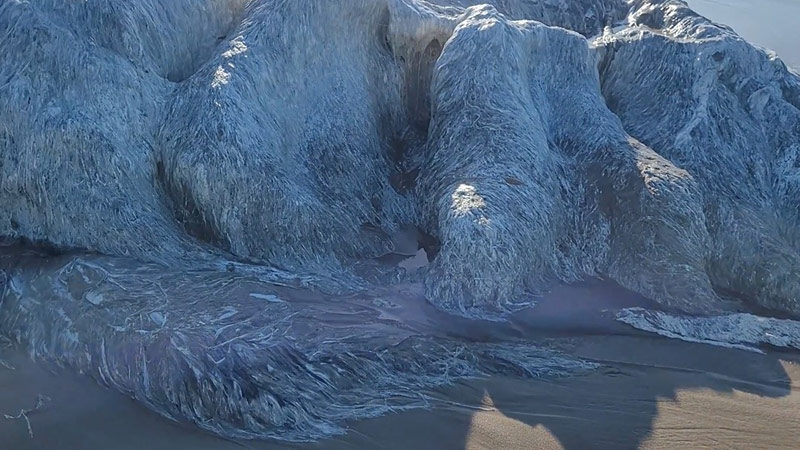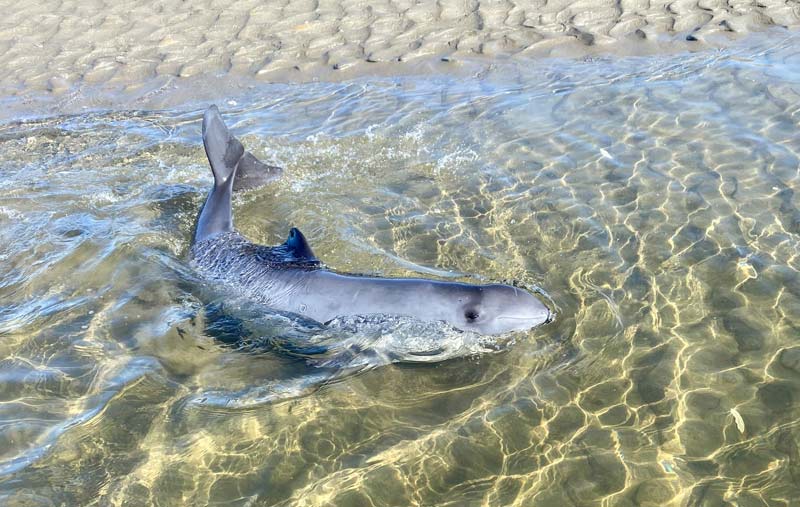4 Freaky Creature Facts from Oregon Coast: Sand Dollars to Almost Paranormal Blobs
Published 7/24/24 at 5:35 p.m.
By Andre' GW Hagestedt, Oregon Coast Beach Connection

(Oregon Coast) – This area is one of the more dynamic shorelines on the planet. Stuff is always changing or washing up; beaches and sand are shifting, and the wonders never cease. The area is known for the odd axiom: don't be surprised to be surprised. (What mystery creature is this? Photo by Rachel Sip - see below)
Includes exclusive listings; some specials in winter
In Cannon Beach:
Includes rentals not listed anywhere else
In Manzanita, Wheeler, Rockaway Beach:
Some specials for winter
In Pacific City, Oceanside:
Some specials for winter
In Lincoln City:
Some specials for winter
In Depoe Bay, Gleneden Beach:
Some specials for winter
In Newport:
Look for some specials
In Waldport
Some specials for winter
In Yachats, Florence
Some specials for winter
Southern Oregon Coast Hotels / Lodgings
Reedsport to Brookings, places to stay; winter deals
Some of the Oregon coast's freakiest moments come from the creatures themselves: the denizens of the deep who end up here and, well, make a splash.
Here are four wowing creature facts from this coastline.
Sand Dollars: Living vs. Dead. More than 90 percent of the time, any sand dollar you find here is going to be dead. In fact, it's rare to find whole ones. Even rarer: a live one.
Tiffany Boothe of Seaside Aquarium said you normally see them all whitish or light gray, but they are a deeper gray to lavender when still alive.

Seaside Aquarium
If you find one that's not that sort of bleached-out look, and it's still fuzzy and a bit colorful, you should definitely leave it alone. That's still alive. You can try throwing it back, but that won't work 99 percent of the time. They can't swim back to the sandy beds they've grown from, and the waves just wash them right in.
The big problem with a live one: it's gonna stink real quick. Nothing quite like dead and rotting seafood in your car, right? Curious Bits About Sand Dollars on Oregon Coast / Washington Coast You Didn't Know

Photo Merica Lynn
Deeply Disgusting Globster. This is where science almost enters the paranormal.
Until about the middle of the last century, people would occasionally find bizarre, dead cryptids on the beach: masses of surreal deceased sea monsters they couldn't identify. In fact, they seemed – and still appear – to be kind of hairy. From ancient times onwards, they were thought to be otherworldly in some way.
They've been termed “globsters,” and what they are is quite simple. A whale corpse decays out there in the Deep Blue and then it starts to break apart. Sometimes, those chunks wash up and they're puzzling in shape. They're also so decayed the flesh looks like hair. It's not: it's just plain ol' disgusting.

Globster in Rockaway Beach / Rachel Sip
Globsters still wash up here on occasion, and it's no happy job to rid of them – like Seaside Aquarium has to when they come ashore in areas like Long Beach, Washington, Seaside, Cannon Beach, Manzanita or Rockaway Beach. Anything south of that is other people's responsibility.
“The last thing you want is that decomposed thing to roll over on you or just touch you, when it’s being knocked around by the tide,” said the aquarium's Tiffany Boothe. Ewww, 'Globsters' of Oregon / Washington Coast and Their Paranormal Past
See the video of a graceful whale sighting at Port Orford. A momma gray whale and calf make a beautiful show.
The Wild, Weird Lancetfish

Seaside Aquarium photo
Another rarity to find on the shore is an odd, prehistoric looking fish called a Pacific Lancetfish. They are common in the waters of the Oregon coast, but it's rare to find one having washed up onshore.
They usually reside in deeper waters and much farther out to sea
The lancetfish can have skin that appears iridescent. It has dagger-like teeth along with striking blue eyes. Most people think they're looking at a barracuda, and they do resemble that with their enormous teeth. In fact, one that washed up on this shoreline in the 2010s years may have died because they are known to accidentally bite themselves in a feeding frenzy.

The lancetfish's large eyes enable them to see in deep water. These are scaleless fish with large teeth and sail-like dorsal fins. Boothe said they can be found worldwide and in almost all oceans, except for the polar oceans. They range in depths from 10 feet to over 3,000 feet. More: Spiky, Bitey-Looking Fish Washing Up on Oregon Coast Lately: Why, What They're Not
Dolphins and Porpoises – and Vice Versa

Seaside Aquarium photo: harbor porpoise
One thing that often happens around here is that people get dolphins and harbor porpoises mixed up. To mess things up even further, the Dall's porpoise off the Oregon coast looks similar to a killer whale.
So what's the difference? Essentially a dolphin has a more triangular dorsal fin and a more beaked snout, while harbor porpoises tend to be stubby and they don't really have a beak. However, a Dall's porpoise can have a streamlined look to its snout, which definitely looks different than, say, a white-sided dolphin around here. Yet it can be confused with a killer whale due to its coloration, or witha dolphin because the mouth area is different.

Seaside Aquarium: striped dolphin
Harbor porpoises are extremely common in these waters, and their populations outnumber actual dolphins by about ten to one here.
A few kinds of dolphins run around Oregon waters, but they rarely wash up onshore even after they've died. The three most common types are striped dolphins, white-sided dolphins and long-beaked common dolphins. Out of those, the striped dolphin has stranded ashore the most in the last 20 years, as documented by Seaside Aquarium.
Oregon Coast Hotels for this event - South Coast Hotels - Oregon Coast Vacation Rentals - Where to eat - Maps - Virtual Tours
Cannon Beach Lodging
Nehalem Bay Lodgings
Manzanita Hotels, Lodging
Three Capes Lodging
Pacific City Hotels, Lodging
Lincoln City Lodging
Depoe Bay Lodging
Newport Lodging
Waldport Lodging
Yachats Lodging
Oregon Coast Vacation Rentals
Oregon Coast Lodging Specials
More About Oregon Coast hotels, lodging.....
More About Oregon Coast Restaurants, Dining.....
 Andre' GW Hagestedt is editor, owner and primary photographer / videographer of Oregon Coast Beach Connection, an online publication that sees over 1 million pageviews per month. He is also author of several books about the coast.
Andre' GW Hagestedt is editor, owner and primary photographer / videographer of Oregon Coast Beach Connection, an online publication that sees over 1 million pageviews per month. He is also author of several books about the coast.
LATEST Related Oregon Coast Articles
From Dino Bones to New and Moving Land Masses: Startling Oregon Coast FactsThe back story of these beaches is a weird one, and the weird stuff keeps happening. Marine sciences, geology, south coast, Cape Sebastian
Weirdest Science: Possible 'Ocean' Beneath the Oregon Coast, North America
Section of the Earth's crust where water does not exist in the usual forms. Geology, Sciences
Oregon Coast Weather Mystery: Did a Waterspout Drop Fish in Lincoln City?
One of the rarest and weirdest of meteorological encounters is a thing called 'animal rain'
Think You Know the Oregon Coast Village of Arch Cape? (Video)
From its history to its weird geology along with the natural nooks 'n crannies
Funky, Freaky and Adorable is One Oregon / Washington Coast Fishie
Described as being like a ping pong ball in the water, a golf ball or a fat little helicopter. Sciences
It Took 11 Years, But Finally a Freaky Oregon Coast Noise Was Recorded
Did you know some tidepool life can talk? Marine sciences
7 Bizarre Basalts of Oregon's North Coast: Lava Frozen in Time
It's an ancient, freaky story ? and a tad frightening. Oceanside, Yachats, Seaside, Newport, Cannon Beach, Newport
Explained: Strangely Colored Tides of Oregon / Washington Coast in Blue, Pink...
Ever walk the beach and discover the waves or the sea foam are a weird color? Marine sciences, Seaside Aquarium
Back to Oregon Coast
Contact Advertise on Oregon Coast Beach Connection
All Content, unless otherwise attributed, copyright © Oregon Coast Beach Connection. Unauthorized use or publication is not permitted



















































